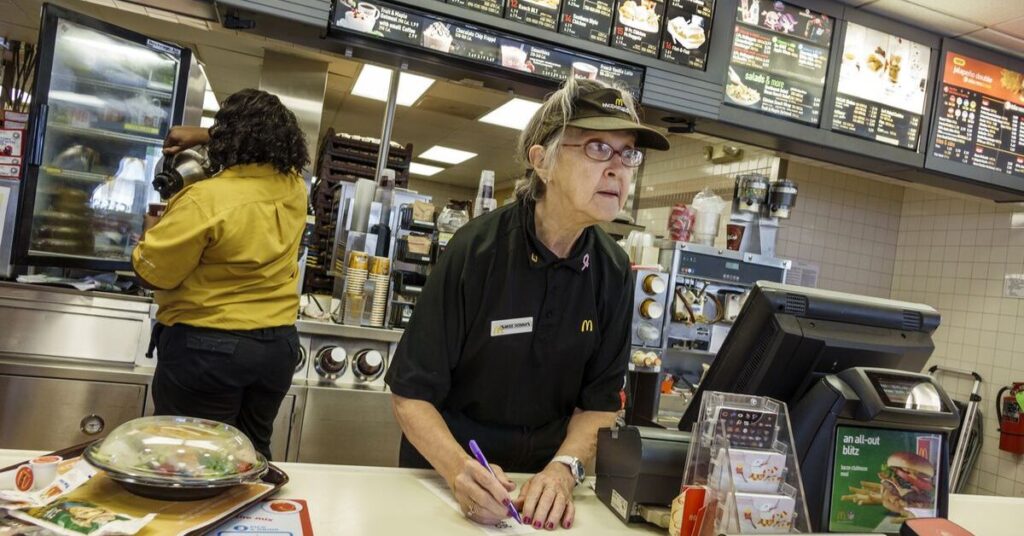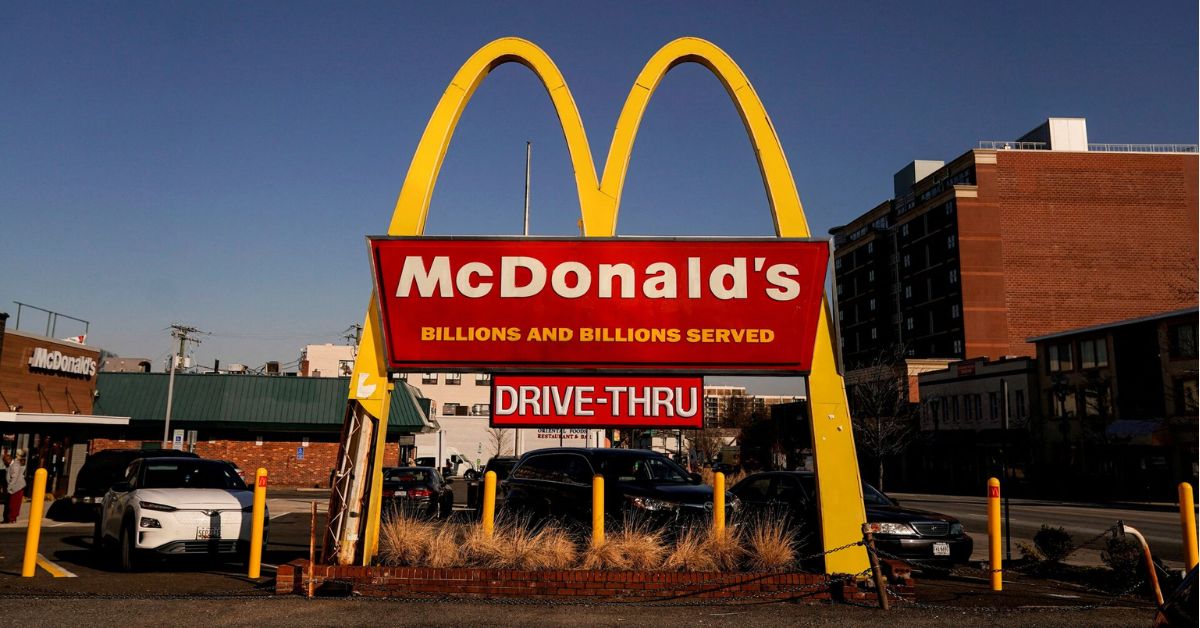A recent viral TikTok video shocked millions when a McDonald’s worker admitted to intentionally ignoring certain customers who greet them. The confession sparked nationwide debate about fast-food customer service standards.
This revelation exposed hidden dynamics between McDonald’s employees and customers that most people never realized existed. Here’s the complete truth behind why your friendly greeting might fall on deaf ears.
The Viral Revelation That Shocked America
Breaking Down the McDonald’s Worker’s Confession
The original TikTok video featured a McDonald’s employee explaining how workers quickly assess customers within seconds of interaction.
She revealed that customers who greet them enthusiastically often receive lukewarm responses based on visual cues and past experiences.
The worker demonstrated how tone, body language, and timing influence whether McDonald’s staff engage meaningfully with customers.
The confession detailed a systematic approach where McDonald’s workers categorize customers into different groups. Some receive full attention and warm responses, while others get minimal acknowledgment despite their polite greetings.
This selective engagement happens so frequently that it’s become an unspoken protocol among fast-food workers nationwide.
Why This McDonald’s Employee Spoke Out
The worker’s motivation stemmed from mounting workplace frustration and a desire to educate customers about service industry realities.
She explained that McDonald’s employees deal with over 400 customer interactions daily, making genuine engagement with every person emotionally exhausting. The confession aimed to bridge the gap between customer expectations and worker capabilities.
Industry experts note that this revelation reflects broader issues within fast-food employment. High turnover rates of 144% annually in quick-service restaurants create environments where workers feel disconnected from customer service ideals.
The McDonald’s worker’s honesty highlighted systemic problems rather than individual shortcomings.
The Hidden Psychology Behind McDonald’s Worker Responses

Customer Profiling Happens in Seconds
McDonald’s workers develop rapid assessment skills through necessity, not malice. Within three seconds of customer approach, employees evaluate potential interaction complexity based on appearance, demeanor, and body language.
Customers wearing business attire typically receive faster service because workers assume they’ll order quickly and leave promptly.
Research shows that fast-food workers unconsciously categorize customers into risk levels. High-maintenance customers often display specific behaviors: checking phones while ordering, asking multiple questions about ingredients, or appearing agitated before reaching the counter.
These visual cues trigger defensive responses from workers who want to minimize difficult interactions.
Survival Mechanisms in High-Stress Environments
The McDonald’s work environment creates intense psychological pressure that affects customer interaction quality. Peak hours see 300% increased stress levels among fast-food workers, according to industry studies.
During rush periods, workers enter survival mode where efficiency trumps friendliness, leading to selective greeting responses.
Emotional labor represents a significant but unrecognized aspect of McDonald’s employment. Workers must maintain cheerful facades while dealing with difficult customers, time pressure, and management demands.
This constant emotional regulation depletes mental resources, causing workers to conserve energy by limiting engagement with certain customer types.
When McDonald’s Customers Get Ignored – The Real Reasons
Timing Matters More Than You Think
McDonald’s workers reveal that greeting responses vary dramatically by time of day. Morning rush customers receive minimal acknowledgment because workers focus on speed over social interaction. Afternoon visitors typically experience warmer service when staff feel less pressured.
Peak performance metrics require McDonald’s employees to maintain specific service times: 90 seconds for drive-thru orders and 60 seconds for counter service. These rigid timelines make extended greetings counterproductive to worker evaluations.
Customers who visit during slower periods receive significantly better attention and genuine responses to their friendly approaches.
The Customer Types McDonald’s Workers Avoid
Certain customer behaviors trigger immediate defensive responses from McDonald’s staff. Aggressive personalities who speak loudly or impatiently often receive minimal interaction regardless of initial politeness.
Workers have learned to identify these traits quickly and adjust their service approach accordingly.
Complicated order customers also face selective greeting responses. Those who typically request multiple modifications, ask about nutritional information, or want to speak with managers get limited engagement.
McDonald’s workers prefer straightforward interactions that don’t disrupt workflow or create additional stress during busy periods.
| Customer Type | Greeting Response | Reason for Avoidance |
| Phone Users | Minimal acknowledgment | Divided attention creates confusion |
| Aggressive Personalities | Professional but cold | Past negative experiences |
| Complicated Orders | Standard service only | Time pressure concerns |
| Repeat Problem Customers | Cautious interaction | Previous incidents |
Industry Secrets: What McDonald’s Workers Won’t Tell You
The Unwritten Rules of Fast-Food Interaction
McDonald’s employees operate under informal codes that customers rarely understand. Eye contact duration serves as a signal between workers about customer difficulty levels. Brief glances indicate normal service, while sustained eye contact warns colleagues about potential problems.
Code words and phrases help McDonald’s staff communicate about customers without direct confrontation. Terms like “special attention” or “careful service” alert team members to adjust their interaction style.
These subtle communications happen constantly but remain invisible to customers who wonder why their greetings receive different responses.
Technology vs. Human Connection at McDonald’s
Self-service kiosks now handle 25% of McDonald’s orders, reducing face-to-face interactions between workers and customers. This technological shift allows employees to focus on food preparation rather than customer engagement, fundamentally changing the greeting dynamic.
Mobile ordering further diminishes traditional customer-worker relationships. Customers using McDonald’s app often bypass greeting opportunities entirely, creating a more transactional experience.
Workers adapt by reserving their social energy for customers who require direct interaction, leading to inconsistent greeting responses.
More Post: WYLL Meaning 2025: What Does “What You Look Like” Mean on Social Media?
The McDonald’s Worker Experience – Behind the Counter Reality
Daily Challenges McDonald’s Employees Face
Minimum wage pressures significantly impact McDonald’s worker motivation and customer service quality. Employees earning $7.25-$15 per hour often feel undervalued, affecting their willingness to provide enthusiastic greetings to every customer.
Financial stress creates emotional barriers that influence workplace interactions.
High turnover rates mean many McDonald’s workers lack extensive customer service training or emotional investment in their positions. New employees often mirror the greeting behaviors of experienced staff, perpetuating selective response patterns.
This cycle continues because 65% of fast-food workers leave within one year.
Training vs. Reality for McDonald’s Staff
Corporate training emphasizes friendly customer service and consistent greeting standards. However, real-world application differs significantly from training scenarios. Workers quickly learn that survival requires energy conservation and risk assessment rather than uniform friendliness.
Management priorities often conflict with customer service ideals. Speed metrics, order accuracy, and cost control take precedence over greeting quality.
McDonald’s workers understand that performance evaluations focus on efficiency rather than customer interaction warmth, leading to strategic greeting choices.
How Customer Behavior Influences McDonald’s Service Quality
The Power of Genuine Politeness
Authentic politeness generates positive responses from McDonald’s workers when customers demonstrate genuine respect rather than performative friendliness.
Workers can distinguish between customers who truly appreciate their service and those who expect enthusiasm without reciprocal courtesy.
Simple phrases that guarantee better service include thanking workers by name, acknowledging their busy schedule, and expressing patience during delays.
These behaviors signal to McDonald’s employees that customers understand their challenges, leading to warmer greeting responses and improved service quality.
Cultural Expectations vs. Workplace Reality
Regional differences in customer service expectations create varying greeting standards across McDonald’s locations. Southern restaurants often maintain higher social interaction levels, while urban locations focus more on efficiency.
Workers adapt their greeting responses to match local cultural norms and customer expectations.
Generational gaps also influence greeting dynamics. Younger customers often prefer minimal interaction and quick service, while older customers expect traditional courtesy.
McDonald’s workers adjust their approach based on perceived customer age and social preferences, leading to inconsistent greeting experiences.
More Post: Your Topics | Multiple Stories: 100+ Creative Ideas
Solutions for Better McDonald’s Customer-Worker Relationships
What Customers Can Do Differently
Understanding worker perspectives represents the first step toward improving McDonald’s interactions.
Customers who recognize the challenges of fast-food employment often receive better service because workers appreciate their empathy and patience.
Practical tips for positive interactions include visiting during off-peak hours, preparing orders in advance, and expressing genuine appreciation for worker efforts.
These simple adjustments create better conditions for meaningful greetings and improved service experiences.
Systemic Changes Needed in Fast-Food Industry
Better wages improve service quality according to multiple industry studies. McDonald’s locations that pay above minimum wage report higher customer satisfaction scores and more consistent greeting standards.
$15 minimum wage implementations show direct correlation with improved worker attitudes and customer interactions.
Improved training programs focusing on emotional intelligence and stress management could help workers maintain greeting consistency.
McDonald’s corporate could implement customer service coaching that addresses real-world challenges rather than idealized scenarios.










